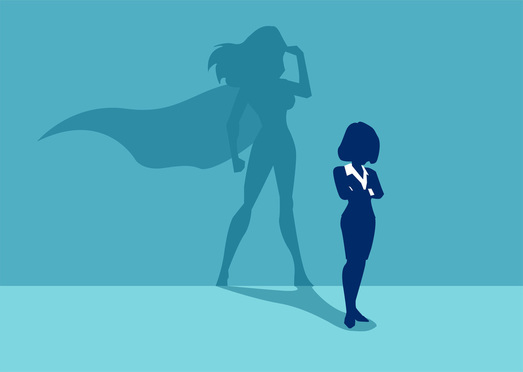What 'Capt. Marvel,' Bribery Scandal, 2018 Midterms Teach Us About Women in Big Law
As our newly reconfigured House of Representatives settles into business and the world of higher ed is reacting to a massive college admissions bribery…
April 29, 2019 at 06:00 AM
5 minute read

As our newly reconfigured House of Representatives settles into business and the world of higher ed is reacting to a massive college admissions bribery scandal, these two stories remind me of why we still see so little progress for women in the legal profession.
The 2018 midterm elections illustrated the fact that, when your stakeholders are energized and organized, big things can happen. But, as the college admissions scandal reminds us, the system is rigged to keep in power those who are already in power, regardless of whether they're truly the best and the brightest.
So, if we want to see big change, we need to focus on energizing stakeholders and unjamming the pipeline.
First, let's talk politics.
In last November's midterm elections, women made record gains in the U.S. House of Representatives. And, while there are many reasons for those wins, it's clear that the country's ultimate stakeholders—the electorate—were energized. Women ran in unprecedented numbers, and voters proved that, when women are on the ballot, they stand a great chance of winning.
Equally as important as an energized electorate, though, was the fact that, almost 35 years ago, EMILY's List was founded with a single purpose: to level the fundraising playing field by providing early funding, training, and campaign support for women candidates (specifically pro-choice, Democratic women candidates). Women candidates have always lagged in fundraising, partly because women haven't been as plugged in to those who write big checks to political candidates, so EMILY's List started laying the groundwork to remedy that for women candidates who support its agenda.
Essentially, EMILY's List saw that the pipeline for women candidates was jammed, and they engineered a fix. And it investment paid off, big time, in 2018.
Away from politics, Hollywood has been giving lip service to diversity and inclusion for ages, but some influential artists are creating their own quotas as a way to unjam the pipeline there.
Ava DuVernay, who created “Queen Sugar” on OWN, hires only women directors for the series, and actress/producer Regina King vowed that all her projects would have at least 50 percent women on the staff. More diverse hires in thousands of behind-the-camera jobs can create a talent pipeline for women and other underrepresented groups that can pay dividends in a surprisingly short period of time.
As for the stakeholders in the entertainment business—ticket buyers and television viewers—they've already shown that they can deliver audiences to well-made shows and movies made by and for women. Despite a serious effort by online trolls to tank the movie, “Captain Marvel” (written and directed by a woman, and featuring a female superhero) made a killing at the box office.
What does all this have to do with the legal profession?
Our stakeholders—the most important of whom are our clients—have an interest in more diverse legal representation. Just as corporate boards are well-served when diverse perspectives oversee the company's decision-making, corporate clients are well-served when their legal teams see problems—and possible solutions—through more than one lens.
Many corporate clients push their outside counsel to improve diversity, but those efforts haven't yet shown much in the way of concrete results. I've heard anecdotes about small firms losing business because their clients were moving their work to firms with greater female and minority representation, but until general counsel show that they're willing to pull work from prestigious law firms—the kind that give them cover from the same boards of directors that also suffer from a lack of diversity—client diversity pushes probably won't amount to much.
As far as unjamming the legal profession's pipeline, that's another problem we haven't found a solution to.
Women make up a little more than half of all law school students, which is encouraging on its face. But once you dive deeper, you learn that, among the Top 20 law schools—the ones that Big Law recruits from most heavily—women make up less than half of those students in 14 of those schools.
Do great lawyers come from law schools other than those in the Top 20? Of course. But there are distinct advantages to attending a top-tier law school, and one of those is being on the radar of top-tier law firms, which are the firms most likely to be hired by top-tier corporate clients.
The legal profession needs the talents of women today even more than it did when I started writing this column in 1997. To achieve parity, its stakeholders—our clients—need to start demanding change, and those in charge of the pipeline—especially top law schools—need to help clear the way.
Kathleen J. Wu is a partner in Hunton Andrews Kurth in Dallas. Her practice areas include real estate, finance and business transactions.
This content has been archived. It is available through our partners, LexisNexis® and Bloomberg Law.
To view this content, please continue to their sites.
Not a Lexis Subscriber?
Subscribe Now
Not a Bloomberg Law Subscriber?
Subscribe Now
NOT FOR REPRINT
© 2025 ALM Global, LLC, All Rights Reserved. Request academic re-use from www.copyright.com. All other uses, submit a request to [email protected]. For more information visit Asset & Logo Licensing.
You Might Like
View All

Nondisparagement Clauses in Divorce: Balancing Family Harmony and Free Speech
6 minute read

Trending Stories
Who Got The Work
J. Brugh Lower of Gibbons has entered an appearance for industrial equipment supplier Devco Corporation in a pending trademark infringement lawsuit. The suit, accusing the defendant of selling knock-off Graco products, was filed Dec. 18 in New Jersey District Court by Rivkin Radler on behalf of Graco Inc. and Graco Minnesota. The case, assigned to U.S. District Judge Zahid N. Quraishi, is 3:24-cv-11294, Graco Inc. et al v. Devco Corporation.
Who Got The Work
Rebecca Maller-Stein and Kent A. Yalowitz of Arnold & Porter Kaye Scholer have entered their appearances for Hanaco Venture Capital and its executives, Lior Prosor and David Frankel, in a pending securities lawsuit. The action, filed on Dec. 24 in New York Southern District Court by Zell, Aron & Co. on behalf of Goldeneye Advisors, accuses the defendants of negligently and fraudulently managing the plaintiff's $1 million investment. The case, assigned to U.S. District Judge Vernon S. Broderick, is 1:24-cv-09918, Goldeneye Advisors, LLC v. Hanaco Venture Capital, Ltd. et al.
Who Got The Work
Attorneys from A&O Shearman has stepped in as defense counsel for Toronto-Dominion Bank and other defendants in a pending securities class action. The suit, filed Dec. 11 in New York Southern District Court by Bleichmar Fonti & Auld, accuses the defendants of concealing the bank's 'pervasive' deficiencies in regards to its compliance with the Bank Secrecy Act and the quality of its anti-money laundering controls. The case, assigned to U.S. District Judge Arun Subramanian, is 1:24-cv-09445, Gonzalez v. The Toronto-Dominion Bank et al.
Who Got The Work
Crown Castle International, a Pennsylvania company providing shared communications infrastructure, has turned to Luke D. Wolf of Gordon Rees Scully Mansukhani to fend off a pending breach-of-contract lawsuit. The court action, filed Nov. 25 in Michigan Eastern District Court by Hooper Hathaway PC on behalf of The Town Residences LLC, accuses Crown Castle of failing to transfer approximately $30,000 in utility payments from T-Mobile in breach of a roof-top lease and assignment agreement. The case, assigned to U.S. District Judge Susan K. Declercq, is 2:24-cv-13131, The Town Residences LLC v. T-Mobile US, Inc. et al.
Who Got The Work
Wilfred P. Coronato and Daniel M. Schwartz of McCarter & English have stepped in as defense counsel to Electrolux Home Products Inc. in a pending product liability lawsuit. The court action, filed Nov. 26 in New York Eastern District Court by Poulos Lopiccolo PC and Nagel Rice LLP on behalf of David Stern, alleges that the defendant's refrigerators’ drawers and shelving repeatedly break and fall apart within months after purchase. The case, assigned to U.S. District Judge Joan M. Azrack, is 2:24-cv-08204, Stern v. Electrolux Home Products, Inc.
Featured Firms
Law Offices of Gary Martin Hays & Associates, P.C.
(470) 294-1674
Law Offices of Mark E. Salomone
(857) 444-6468
Smith & Hassler
(713) 739-1250






